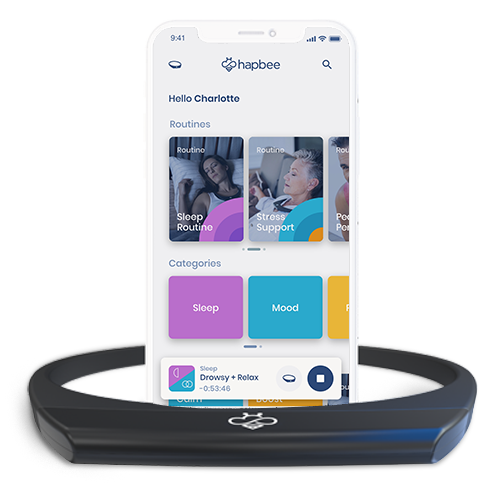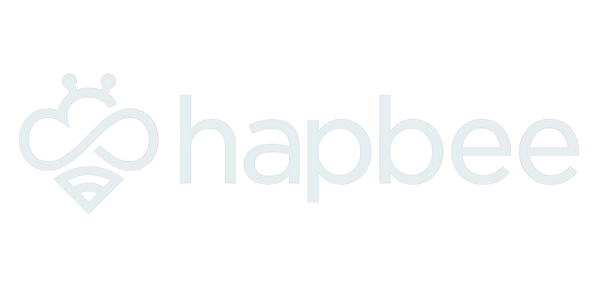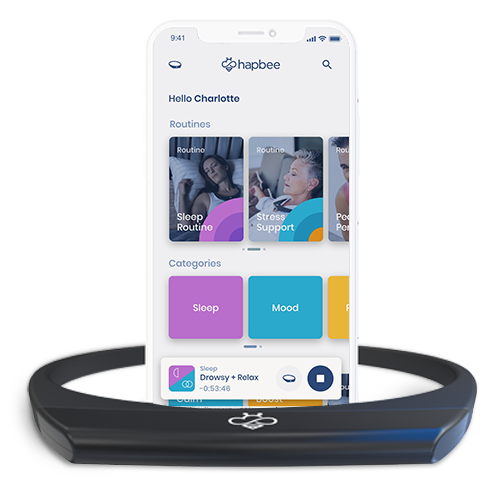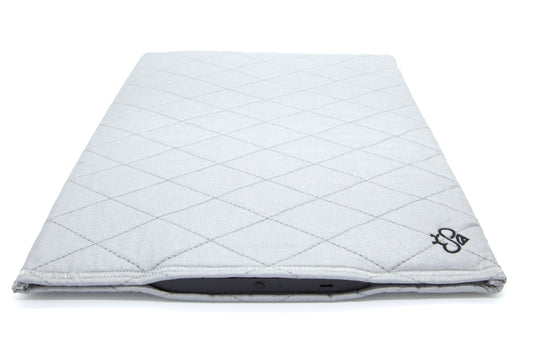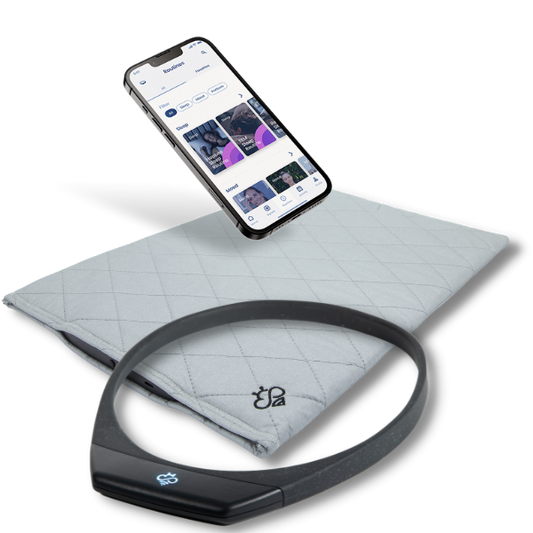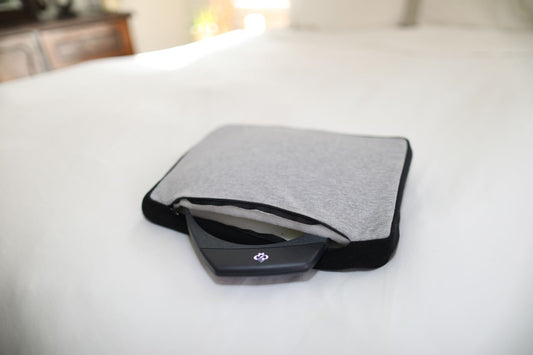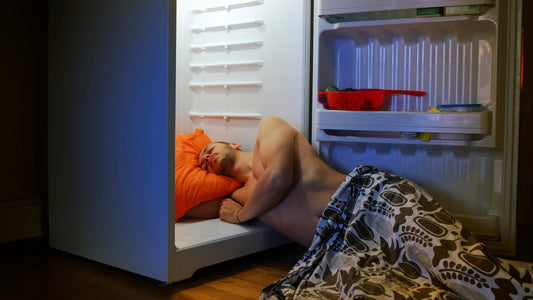Have you ever felt like you need to rest, but sleep just doesn't seem to cut it?
If so, you might be interested in a relatively new concept called Non-Sleep Deep Rest (NSDR).
NSDR refers to a state of deep relaxation that is distinct from sleep, but which may provide similar benefits for physical and mental restoration and recovery. NSDR is gaining popularity among wellness enthusiasts and health experts alike as a way to reduce stress and anxiety, promote deeper relaxation, and enhance overall well-being.
The concept of NSDR is rooted in the understanding that the human body and mind require periods of rest and recovery in order to function optimally. Sleep is one of the most well-known and studied ways in which the body and mind can rest and recover, but it is not the only way. NSDR offers an alternative method for achieving deep relaxation and recovery that can be done in a shorter period of time than sleep.
NSDR is a state that is characterized by reduced activity in the sympathetic nervous system (which is responsible for the body's "fight or flight" response) and increased activity in the parasympathetic nervous system (which is responsible for the body's "rest and digest" response). This state is achieved through various techniques, such as focused breathing, visualization, or body scanning, that allow the mind to enter a state of deep relaxation while remaining awake and alert.
In this article, we will explore what NSDR is, how it works, and how you can incorporate it into your daily routine to optimize your health and wellness. We will also discuss the potential benefits of NSDR and how wearable signals like those provided by Hapbee can help enhance your NSDR practice. Whether you're looking to reduce stress, improve your sleep quality, or enhance your overall well-being, NSDR may be a valuable addition to your self-care routine.
What is Non-Sleep Deep Rest?
Non-Sleep Deep Rest (NSDR) is a relatively new concept that has been gaining attention in the health and wellness world.
Simply put, NSDR is a state of deep relaxation that is distinct from both sleep and meditation. Unlike sleep, which is a natural physiological process that the body undergoes, NSDR is a deliberate and conscious practice that involves relaxing the mind and body to achieve a deep state of rest.
NSDR is also different from meditation, which typically involves focusing the mind on a specific object or thought in order to achieve a state of calmness and clarity. While both NSDR and meditation can be used to promote relaxation and reduce stress, NSDR is often described as a more passive and effortless form of relaxation.
The science behind NSDR is still in its early stages, but some researchers believe that it may have a variety of benefits for the mind and body. One theory is that NSDR helps to activate the parasympathetic nervous system, which is responsible for regulating many of the body's "rest and digest" functions. By doing so, NSDR may help to reduce the body's stress response and promote feelings of calmness and well-being.

Hapbee is a really fascinating device that emits frequencies that tricks your brain into believing it's taking on any kind of neurotransmitter including melatonin, which is the neurotransmitter that helps you sleep"
How to Do Non-Sleep Deep Rest
There are a few different approaches to achieving NSDR, but two primary techniques have been promoted by Dr. Andrew Huberman, a neuroscientist and professor at Stanford University.
- The first technique involves focusing on the breath while lying down in a quiet and comfortable place. The goal is to breathe slowly and deeply, allowing the mind and body to relax with each breath. Dr. Huberman recommends starting with a session of 15-20 minutes and gradually working up to longer periods of time.
- The second technique involves engaging in a specific type of visualization, where one imagines a peaceful and calming scene or experience. This can be done either with eyes closed or open, and the key is to fully immerse oneself in the visualization and let go of any distracting thoughts.
It's important to note that NSDR is not the same as sleep, and it's possible to achieve NSDR even if you are not feeling tired. The key is to allow yourself to fully relax and let go of any tension or stress in the body and mind.
In addition to these techniques, there are also various tools and technologies that can help facilitate NSDR. One such tool is the Hapbee wearable device, which uses ultra-low frequencies to stimulate specific feelings and sensations in the body. By using Hapbee, individuals can more easily achieve a state of relaxation and calmness, which may help to promote NSDR.
Non-sleep deep rest is a powerful technique for eliciting the relaxation response and inducing a state of deep relaxation. With regular practice, NSDR can help reduce stress, improve sleep quality, and enhance overall well-being
The Benefits of Non-Sleep Deep Rest
NSDR has been shown to have a number of potential benefits for both physical and mental health. Here are some of the key benefits:
Reduced stress and anxiety: NSDR can help to activate the parasympathetic nervous system, which is responsible for relaxation and rest. By reducing stress and anxiety, NSDR can help to improve overall well-being and reduce the risk of stress-related health issues.
Improved sleep: While NSDR is not the same as sleep, it can help to improve the quality of sleep by promoting relaxation and reducing stress. This, in turn, can lead to better mood, energy, and productivity during waking hours.
Increased focus and productivity: NSDR can also help to improve focus and productivity by promoting mental clarity and reducing distractions. This can be especially helpful for individuals who struggle with attention and focus during the day.
Enhanced creativity and intuition: NSDR can help to activate the right hemisphere of the brain, which is responsible for creativity and intuition. By tapping into this part of the brain, individuals may experience enhanced creativity, intuition, and problem-solving abilities.
Improved overall health: By reducing stress and improving sleep quality, NSDR may also have a positive impact on overall physical health, including immune function, cardiovascular health, and more.
Overall, NSDR is a powerful tool for promoting relaxation, reducing stress, and improving overall health and well-being. Whether through specific techniques or wearable technologies like Hapbee, there are many ways to incorporate NSDR into your daily routine and experience the many benefits it has to offer.
How Can Hapbee Technology Enhance Non-Sleep Deep Rest?
Non-sleep deep rest can be a powerful tool for promoting relaxation and reducing stress. However, there are ways to enhance the experience even further with the help of modern technology. Hapbee is a wearable device that uses electromagnetic signals to deliver specific frequencies to the brain. By using Hapbee during non-sleep deep rest, individuals can promote even deeper relaxation and enhance the benefits of the practice.
Hapbee offers a variety of signal programs that can be used to enhance the NSDR experience, including "Calm" and "Relax." These programs deliver frequencies that promote relaxation and calmness, helping to reduce stress and anxiety. In a recent video, Dr. Andrew Huberman discussed the potential benefits of using technology to enhance relaxation and promote better sleep. It is also suggested that Hapbee technology could be a useful tool for enhancing NSDR.
Research has shown that electromagnetic signals can have a positive impact on the brain and nervous system. For example, one study found that low-frequency electromagnetic stimulation can improve sleep quality and reduce symptoms of anxiety and depression. By using Hapbee technology to enhance NSDR, individuals can experience even greater benefits and improve their overall health and well-being
How Hapbee Technology Can Help Improve NSDR
While there are several methods and techniques for achieving NSDR, Hapbee's wearable technology can provide a unique advantage. Hapbee uses low-frequency electromagnetic fields to stimulate specific regions of the brain, allowing users to experience different moods and states of mind. By using the Hapbee device during NSDR practice, users may be able to enhance the experience and potentially achieve deeper levels of relaxation.
Hapbee offers specific "Signals" designed to promote relaxation and calm, including Relax, Deep Sleep, and Zen. These signals use low-frequency electromagnetic fields to stimulate the brain and promote a state of relaxation. Users can choose the signal that works best for them and use it during their NSDR practice.
In addition, the Hapbee app provides guided meditations and breathing exercises that can be used during NSDR. These exercises can help users relax and focus their mind, enhancing the NSDR experience.
Overall, Hapbee's technology can be a useful tool for those looking to improve their NSDR practice. By using Hapbee's signals and guided meditations, users may be able to achieve deeper levels of relaxation and potentially experience greater benefits from their NSDR practice.
Non-Sleep Deep Rest (NSDR) Conclusion
Non-Sleep Deep Rest (NSDR) is a new concept that has gained popularity in recent years as a way to achieve deep relaxation and potentially improve overall health and well-being. While NSDR shares similarities with meditation, it differs in its focus on physical relaxation rather than mental focus. NSDR can be achieved through various techniques, including focused breathing and muscle relaxation.
The benefits of NSDR are numerous, including reduced stress and anxiety, improved sleep, and increased energy levels. However, achieving NSDR can be challenging for some people, and it may take time and practice to master the techniques.
Hapbee's wearable technology and app can provide a unique advantage for those looking to improve their NSDR practice. By using Hapbee's relaxation signals and guided meditations, users may be able to enhance their NSDR experience and potentially achieve deeper levels of relaxation.
Overall, NSDR is a promising concept that has the potential to improve our health and well-being. With the help of Hapbee's technology, achieving NSDR may be more accessible and effective for many people.
Additional NSDR Resources
If you're interested in learning more about Non-Sleep Deep Rest and how it can improve your health and well-being, there are many resources available. Here are a few to get you started:
- The Huberman Lab podcast: Dr. Andrew Huberman's podcast is an excellent resource for learning more about NSDR, as well as other topics related to neuroscience and health.
- The Huberman Lab YouTube channel: Dr. Huberman's YouTube channel features a variety of videos on NSDR and related topics, including guided meditations and instructional videos on specific techniques.
- The Hapbee app: Hapbee's app offers a variety of relaxation signals and guided meditations that may help enhance your NSDR practice.
- Books on NSDR: There are several books available on the topic of NSDR, including "The Art of Non-Sleep Deep Rest" by Guy Worthy and "Non-Sleep Deep Rest: A Practical Guide" by Daniel Arbelaez.
By exploring these resources and continuing to practice NSDR, you may be able to experience the numerous benefits of this powerful relaxation technique.
